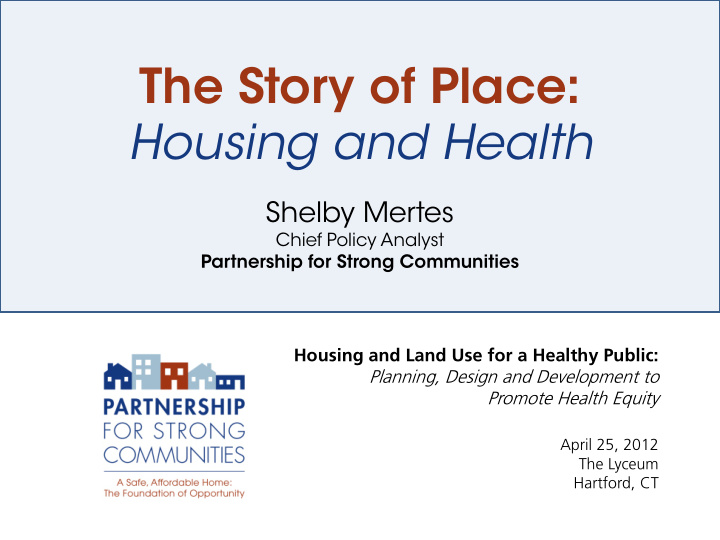



The Story of Place: Housing and Health Shelby Mertes Chief Policy Analyst Partnership for Strong Communities Housing and Land Use for a Healthy Public: Planning, Design and Development to Promote Health Equity April 25, 2012 The Lyceum Hartford, CT
Connecticut housing is expensive CT is 47 th in units built per capita: 6 th highest rents, 8 th highest ownership costs $23.58 / hour housing wage (to afford typical 2BR apartment) 26% of renters earn below 50% Area Median Income, and spend more than 50% of income on rent (affordable = 30% of income on housing)
Connecticut housing is expensive
Connecticut housing is expensive Housing is typically the largest expense in a household budget. Paying too much for housing means not enough for… Health care – insurance, copays, etc. Prescriptions Nutritious (or enough) food Heating/cooling Clothes Decent housing
Connecticut housing is expensive Parents work more to pay for housing. Less time spent with kids. Potential for… Quick meals, snacks More TV Poorer school performance Substance abuse Sexual activity Gangs, violence
Connecticut housing is expensive Housing instability… Overcrowding Couch surfing Emotional stress. Hotbedding • Communicable disease. Domestic conflict. • Lack of privacy. Exhaustion. Eviction School disruption. Foreclosure Frequent moves
Connecticut housing is expensive Homelessness… Small health problems worsen – exposure, stress, poor sleep. Followup care difficult – prescriptions, medical equipment. EXPENSIVE!! • Worse health • Emergency rooms as primary care • Followup/coordination difficult
Connecticut housing is expensive Homelessness… • Homeless shelters at 100% of capacity for the last three years. Often over capacity. • Family homelessness increased 15% between 2010 and 2011. • Homelessness Prevention and Rapid Re-Housing Program (HPRP) – funded by ARRA stimulus – served 2,200 households since 2009, but 12,600 sought assistance.
Expensive housing impact on place
Expensive housing impact on place Opportunity Mapping: Education Quality and Opportunity Economic Health & Transportation Neighborhood Stability
Expensive housing impact on place Uneven playing field = 500 nonwhites
Expensive housing impact on place A de-facto apartheid… In more affluent communities: In poorer communities: • Housing more expensive • Housing expensive, but less so • Higher quality housing • More unhealthy housing • Few affordable housing units • More affordable housing units • Low-density zoning • Density • High-resource/low-poverty schools • Overburdened schools • Less crime • Higher crime • More opportunities • Few opportunities
Expensive housing impact on place Deeper concentrations of poverty lead to “hotspots” of poor health
Expensive housing impact on place These hotspots cost millions of dollars: • Emergency rooms • Clinics, doctors • Burden on schools • Lost work time • Disability, underemployment • Homelessness
Expensive housing impact on place Neighborhood impacts: Substandard Housing Low-income tenants can’t Some landlords lack income afford much rent. to afford maintenance. Low-income tenants have Landlords have little incentive few choices. to maintain apartments Mold, insects: Lead Asthma Asbestos Injuries
Expensive housing impact on place Neighborhood impacts: Crime Assaults, drugs Unsafe to play Obesity, stress outside Few grocery Poor nutrition, stores obesity
Expensive housing impact on place Suburban low-density zoning: Intentions: Results: • Maintain community • Expensive housing character • Lost economic • Limit traffic, noise, etc. opportunity • Protect town budget • Spread-out development (schools, services)
Expensive housing impact on place Effects of spread-out development: Drive instead of Less exercise, walking, biking More obesity Transit inefficient More air pollution
What Should We Do?
What Should We Do? More housing affordability in more places… Use affordable housing programs in communities of opportunity OPPORTUNITY: $500M in new state capital • Preserve existing affordable housing • Construct/rehab new affordable housing • Supportive housing = housing + services Rent vouchers to allow choice of where to live More communities zone for higher-density, mixed-income housing
What Should We Do? HOMEConne onnecticut ut pa participa pation… on…
What Should We Do? More housing affordability in more places… More communities zone for higher-density, mixed-income housing. Even better if retail, jobs, entertainment, transit mixed in. Additional health benefits: Walking, biking, More exercise, less obesity. transit. Less air pollution.
What Should We Do? More housing affordability in more places… More communities zone for higher-density, mixed-income housing. Many other benefits: • Helps local businesses – We customers, workers nearby • Town efficiency – roads, services, school buses have • Energy efficient allies! • Better for climate/environment • Convenient – live near needs
What Should We Do? In struggling communities/neighborhoods, tap into housing demand… Decent, moderately-priced housing WILL rent up. Attract young adults. Get them involved. Focus on tipping-point blocks/neighborhoods: A little help will attract residents, development, businesses, investment.
What Should We Do? In struggling communities/neighborhoods, tap into housing demand… Placemaking: • Coordinated policies • Targeted investment • Make it interesting • Little things make big value - landscaping, signage, neighbors Streamline regulations: • Quicker decisions • Clearer guidelines • Developer friendly: time is money
What Should We Do? Take advantage of new transit… New Haven – Springfield Rail Hartford – New Britain Busway Stations on these lines perfect for: • Mixed-income neighborhoods • Housing density • Walk to transit, and much more • Jobs, economic growth • Bringing investment to struggling neighborhoods
What Should We Do? Take advantage of new transit… Transit helps a household budget, freeing up money for housing, food, clothing, health care, etc. Portion of household budget spent on transportation Far from transit 26% Average 19% Walkable to transit 9%
What Should We Do? Use data and mapping… • Understand connections between policy areas. • See dynamics of places. • Experiment. • Target investments: right approach, right time, right place. • Set goals. Track results. Notice success.
What Should We Do? Work together Be persistent
Shelby Mertes Chief Policy Analyst shelby@pschousing.org 860.244.0066 Partnership for Strong Communities at The Lyceum 227 Lawrence Street Hartford, CT 06106 www.pschousing.org
Recommend
More recommend